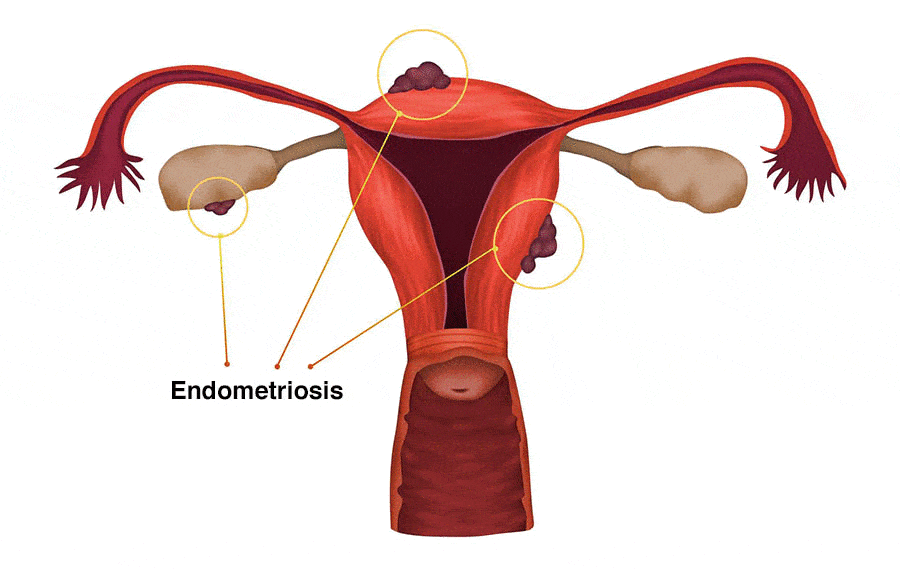We all have medical questions that we want answered – that’s why Dr. Amna Asif is here to provide us with her expert opinion! Every other week, she will be sharing her expert advice with us regarding a range of topics our followers are interested in learning more about. This week in Doc Talk, she gives us a run through of a condition that often goes undiagnosed in women, but causes them severe pain during their menstrual cycle and can result in further complications – endometriosis. Read ahead to find out more:

Are you suffering from severe period pain? Do you have difficulty conceiving? If yes, you could possibly be suffering from endometriosis. But of course, only a doctor can diagnose you with that. However, it is not okay to have such severe period pain that you are missing school, work and other activities.
What Is Endometriosis?
Endometriosis is a painful chronic menstrual health disorder that can be hard to diagnose. Endometriosis occurs when cells similar to those that line the uterus – the endometrium – grow in locations outside the uterus, and in other parts of body. About 1 in 10 women suffer from Endometriosis which often starts as early as teenage.
Symptoms are variable and this may contribute to 7 to 12 years of a delay in diagnosis. The lining of uterus normally responds to the sex hormones oestrogen and progesterone. In women with endometriosis, these endometrium-like cells that are growing outside the uterus also respond to these hormones. During ovulation, the endometrium and the endometrium-like cells thicken. Unlike the endometrium, the misplaced endometrium-like cells cannot leave the body via menstruation. They bleed, cause inflammation and pain, and then heal. Over time, this process can create scar tissue. Fibrous scar tissue can form on the lining inside the abdomen (the peritoneum), causing the uterus, ovaries, fallopian tubes and bowel to stick to each other.
Symptoms
The pain of endometriosis can be so bad that it stops you from going to work or school. Usually, it causes pain around the time of your period, but for some women, the pain is almost constant. If you need treatment, you may need emotional as well as physical support.
The symptoms of endometriosis include:
- Painful periods
- Pelvic pain, lower back and thighs pain
- Ovulation pain
- Pain with sex
- Reduced fertility
- Bowel symptoms – pain using your bowel
- Bladder symptoms – pain when passing urine
- Lethargy
- Premenstrual symptoms.
Many women think that painful periods are normal. But it may be due to Endometriosis.
Causes
The causes of endometriosis are not known. Contributing factors can include:
- Backward Menstrual (period) blood flow throu fallopian tubes into the pelvis. This blood can contain cells from the endometrium. In some women, these endometrial cells stick onto the surfaces of pelvic organs and start growing.
- Family history of Endometriosis – 10 times more risk
Risk Factors
No one case of endometriosis is the same and the risk factors will vary for each individual. That’s why it’s important to consult a doctor and understand your personal condition and it’s effects. These are some potential suspected risk factors:
- Family history of Endometriosis
- Long or heavy periods
- Frequent periods or short cycles
- Starting your period before 11
- Having your first pregnancy when you’re older
- Problems with the immune system
- Low body weight or obesity

How Is It Diagnosed?
To diagnose endometriosis, your doctor will probably ask about your symptoms and periods. You may need to have a laparoscopy (the keyhole surgery) which is a type of surgery that allows doctors to look for endometriosis tissue in your abdomen.
Treatment
There are many options for managing and treating endometriosis including:
- A healthy lifestyle
- Pain-relief medications
- Hormone therapy such as the combined oral contraceptive pill and progestins.
- Different types of surgeries can be offered, including laparoscopy, laparotomy or hysterectomy depending on age, symptoms and individual circumstances.
The right treatment for you will depend on your symptoms, the severity of the condition and whether you are trying to become pregnant or maintain your ability to have children.
I can’t emphasize enough the importance of stress management related to endometriosis. Finding ways to manage the stress that endometriosis can create is important for your wellbeing.
- Try gentle yoga techniques
- Try relaxation skills such as mindfulness therapy
- Organise your day so you always have some time out for yourself
- Seek help from a psychologist or counsellor

Let’s Get The Facts Straight
Myth: It is easy to diagnose Endometriosis.
Fact: Surgery/Laproscopy is the only way to tell for certain whether you have endometriosis.
Myth: Women with endometriosis can not have children.
Fact: Although about a third of women with endometriosis have trouble conceiving, surgery can increase your chances of pregnancy.
Myth: Pregnancy cures endometriosis.
Fact: No. Although endometriosis symptoms may go away in pregnancy, they usually return after pregnancy.
Myth: Hysterectomy (removal of uterus) cures endometriosis.
Fact: Hysterectomy may be considered to help you cope with symptoms, but only when other treatments have not helped; mot every case requires this.
Myth: Women with endometriosis should avoid exercise.
Fact: Physical activity is good for your general health and may ease your symptoms. Try to have an exercise routine for about 30 minutes most days of the week.









What do you think?
You must be logged in to post a comment.